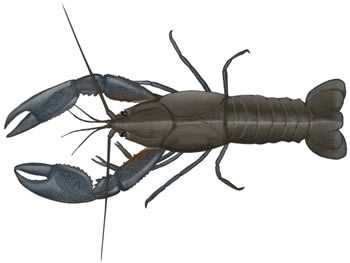Difference between Lobster and Yabby
Key Difference: Lobsters and Yabbies are two types of crustaceans. Both lobsters and yabbies are invertebrates with a hard protective exoskeleton. The common yabby is a crustacean similar to lobsters, however, unlike a lobster, the common yabby is a type of crayfish. Yabbies look like miniature lobsters.

Lobsters and Yabbies are two types of crustaceans. Crustaceans are a very large group of arthropods, which means that they have an exoskeleton, which they molt to grow. Unlike other arthropods, crustaceans have biramous (two-parted) limbs.
Both lobsters and yabbies are invertebrates with a hard protective exoskeleton. Similar to other arthropods, they must molt their exoskeleton in order to grow. However, when they molt their exoskeleton, they are very vulnerable.
There are many crustaceans that have the word "lobster" in their names, however, only the clawed lobsters of the family Nephropidae are considered as true lobsters. Lobsters have 10 walking legs. The front three pairs have claws, the first of which is the largest. These are what gives the lobsters their distinctive look. Lobsters also have antennas on the top of their head, which they use as sensors in the water and to communicate. The closest living relatives of clawed lobsters are the reef lobsters and the three families of freshwater crayfish.
It has been estimated that lobsters live up to 70 years old. In fact, research suggests that lobsters may not slow down, weaken, or lose fertility with age, and instead older lobsters may be more fertile than younger lobsters.
The name yabby is given to two different kinds of crustacean in Australia. These are the freshwater yabby and the marine yabby. The marine yabby is a type of ghost shrimp which lives in deep burrows in mudflats or sandbanks, especially in or near estuaries in the intertidal zone. These are commonly used as bait for fishing, especially in Queensland and northern New South Wales. The bass yabby is a common species that is found in south-eastern Australia.

The freshwater yabby is the more commonly known yabby. It is a type of crayfish belonging to the genus Cherax. These are often caught for food and can be found indams, ponds, lakes and rivers in Australia's Eastern States. The common yabby is the most common type of freshwater yabby. However, the term ‘yabby’ is commonly used to refer to many different types of crustaceans, commonly different types of crayfish, however, these are not officially considered yabbies. Only the Cherax destructor is officially called a yabby.
The common yabby is a crustacean similar to lobsters, however, unlike a lobster, the common yabby is a type of crayfish. Yabbies are found in swamps, streams, rivers, reservoirs and farm dams at low to medium elevations. Their body structure is very similar to lobsters. They also have 10 walking legs. The front three pairs have claws, the first of which is the largest. They also have antennas on the top of their head, which they use as sensors in the water and to communicate. They also have the distinctive tail of the lobster. However, the major difference between a yabby and a lobster is that yabbies look like miniature lobsters.
Another difference between them is that lobsters generally live in the sea. The true lobsters, which humans use as a food source can be found in two main locations, the European Lobster can be found on the Atlantic Coast of Europe, Scandanavia and in the Mediterranean, while the American Lobster can be found on the Atlantic Coast of North America. Whereas, yabby are not found in the sea, but rather in freshwater such as creeks, streams, etc. Also, yabbies are only found in Australia.
|
|
Lobster |
Yabby |
|
Kingdom |
Animalia |
Animalia |
|
Phylum |
Arthropoda |
Arthropoda |
|
Subphylum |
Crustacea |
Crustacea |
|
Class |
Malacostraca |
Malacostraca |
|
Order |
Decapoda |
Decapoda |
|
Suborder |
Pleocyemata |
Pleocyemata |
|
Infraorder |
Astacidea |
Axiidea |
|
Family |
Nephropidae |
Parastacidae, Callianassidae |
|
Species |
More than 500 species |
C. destructor, T. australiensis |
|
Appearance |
Lobsters have long bodies with muscular tails, and live in crevices or burrows on the sea floor. Three of their five pairs of legs have claws, including the first pair, which are usually much larger than the others. The lobster's head bears antennae, which are used as sensors. Lobsters, like snails and spiders, have blue blood due to the presence of haemocyanin which contains copper. |
Color is highly variable and depends on water clarity and habitat; yabbies can range from black, blue-black or dark brown in clear waters to light brown, green-brown or beige in turbid waters. Yabbies specifically bred to be a vibrant blue colour are now popular in the aquarium trade in Australia. |
|
Habitat |
Lobsters are found in all oceans and found on land. They live on rocky, sandy, or muddy bottoms from the shoreline to beyond the edge of the continental shelf. They generally live singly in crevices or in burrows under rocks. |
Yabbies are found in swamps, streams, rivers, reservoirs and farm dams at low to medium elevations. Yabbies are commonly found in Victoria and New South Wales, although the species also occurs in southern Queensland, South Australia androughout parts of the Northern Territory. It has been introduced to Western Australia. Yabbies are found in many ephemeral waterways, and can survive dry conditions for long periods of time (at least several years). |
|
Size |
It has been estimated that lobsters live up to 70 years old. Lobster longevity allows them to reach impressive sizes. According to Guinness World Records, the largest lobster ever caught was in Nova Scotia, Canada, weighing 20.15 kilograms (44.4 lb). In general, lobsters are 25–50 cm (10–20 in) long. |
Yabbies occasionally reach up to 30 cm (12 in) in length but are more commonly 10–20 cm (4–8 in) long. Yabbies grow to a maximum size of 350 gram, however, the common large size is 120 – 150 gram. |
|
Sexual dimorphism |
Males are often larger in size than females. Males also have a longer and wider shell than the females. Females have small sternal spines and long second pleopod as compared to male. Females also have wider tails than males because that is where she carries her eggs. Males have hard pleopeds, while females have soft, feathery pleopods. |
Male yabbies have small projections on the inside base of the last walking pair of walking legs. The female yabbies are smooth on the back legs without any projections but have 2 round openings on the inside base of the third pair of legs, they are hard to discern but these are the openings from which the females will lay her eggs under her tail. |
|
Reproduction |
The female releases pheromones (chemicals) into the water to let nearby males know she is preparing to molt and mate. If there are multiple males interested in the female, they will fight each other for her. The lobster that wins the fight will take the female into his cave and protect her from predators since she is vulnerable while molting. Once she has shed her hard exoskeleton, the male gently turns her over and pierces her abdomen with his first pair of pleodods. He deposits sperm packets into her sperm receptacles; these she will store for up to 15 months before she releases eggs. When the female judges the time is right, she releases the eggs which pass by the seminal receptacle and are fertilized with the stored sperm. She will carry these eggs under her tail for the next ten to eleven months. When the eggs hatch, the baby lobsters don’t look like their parents. |
Yabbies begin a breeding cycle in the summer months, when the water temperature is greater than 14ºC and day length starts to increase. Given plenty of food and correct conditions, a ratio of one male to two females seems to stimulate the mating instinct and increases the chance of a successful mating. The ideal sizes to use when mating yabbies are females of 70 to 90mm and males of 100 to 120mm. Larger females can be quite choosy and don’t mate as regularly as the smaller females, whereas it does not seem to matter what size the male is. Once they mate, the females takes the sperm and fertilizes her eggs. She then carries between 100 and 1,000 eggs, under her tail. It takes between 19 and 40 days for the eggs to hatch and the babies are released into the water.
|
|
Behaviour |
Lobsters move by slowly walking on the sea floor. However, when they flee, they swim backward quickly by curling and uncurling their abdomen. A speed of 5 m/s (11 mph) has been recorded. This is known as the caridoid escape reaction. They are known to resort to cannibalism in captivity. However, when lobster skin is found in lobster stomachs, this is not necessarily evidence of cannibalism - lobsters eat their shed skin after moulting. |
Yabbies like to burrow and often hide out at the bottom of muddy creeks and swamp beds. Yabbies shed their shell to grow bigger, which can take up to 6 hours, depending on their size. During this time they normally fast & stay in hiding. Some may even eat their shell. Yabbies have a life span of only 5 – 7 years under average conditions, in the wild their life expectancy is much shorter as they are towards the bottom of the food chain and a vast amount of animals consume them. Some of their main predators are insect larvae, fish, eels, turtles, birds and water rats. |
|
Diet |
Lobsters are omnivores and typically eat live prey such as fish, mollusks, other crustaceans, worms, and some plant life. They scavenge if necessary, and are known to resort to cannibalism in captivity. |
Yabbies are primarily nocturnal detritivores, feeding primarily on algae and plant remains, at night, but also opportunistically feeding on any fish or animal remains they encounter at any time of day. |
|
Human consumption |
Highly prized as seafood, lobsters are economically important, and are often one of the most profitable commodities in coastal areas they populate. Cooks boil or steam live lobsters. The lobster cooks for seven minutes for the first pound and three minutes for each additional pound. Lobster recipes include Lobster Newberg and Lobster Thermidor. Lobster is used in soup, bisque, lobster rolls, and cappon magro. Lobster meat may be dipped in clarified butter, resulting in a sweetened flavour. In North America, the American lobster did not achieve popularity until the mid-19th century, when New Yorkers and Bostonians developed a taste for it. Prior to this time, lobster was considered a mark of poverty or as a food for indentured servants or lower members of society. |
While less common than prawns and other crustaceans, yabbies are eaten in Australia much like crayfish in other countries. Usually yabbies are boiled and eaten plain or with condiments. Yabbies are also occasionally served at restaurants, where they may be prepared in salads, ravioli, pasta, etc. |
|
Cultural influences |
Highly prized as seafood, lobsters are economically important, and are often one of the most profitable commodities in coastal areas they populate. |
Yabbies are an important dietary item for Australian native freshwater fish like Murray cod and golden perch. |
Image Courtesy: great-maine-vacations.com, dpi.nsw.gov.au









Add new comment